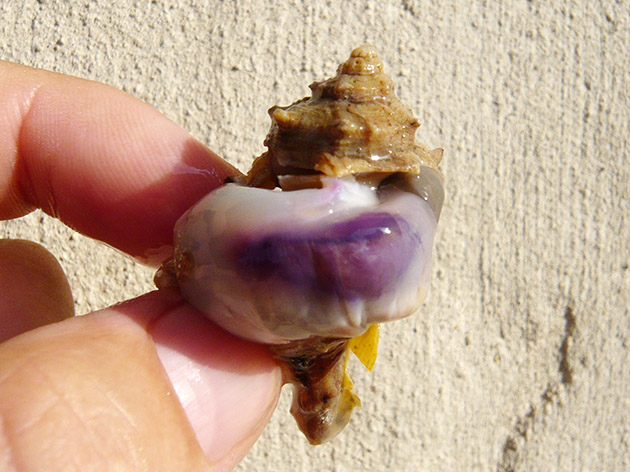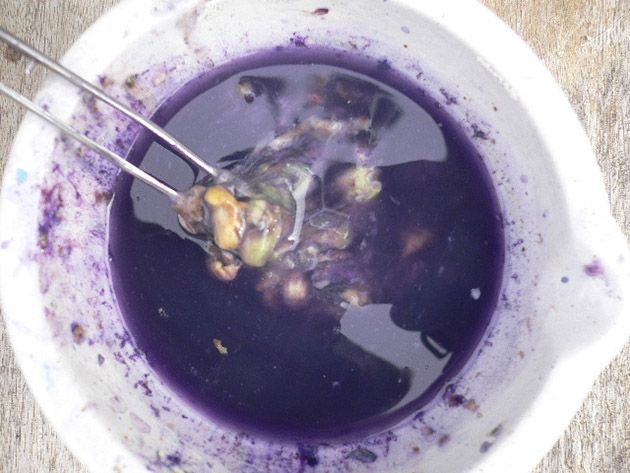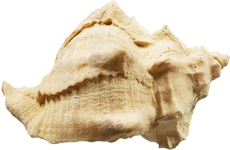
Dyeing with purple pigment
Ancient and forgotten colours
Inge BOESKEN KANOLD, is an artist with a special interest in ancient and forgotten colours. She began research on colours during her 14-year stay in Asia during the seventies.
In 1975, for the first time since independence, indigo was harvested in Indonesia, and she was able to obtain a few grams of this rare blue pigment. Travelling in India, she found yellow orpiment and on Bali cinnabar, black from soot and white made from calcinated pig bones.
In 1979, while living in Beirut, Lebanon she tried, helped by scientists, to produce the pigment of ancient purple, using the secretion of a mollusc called murex Hexaplex trunculus.
Since 1982 she has lived and worked in Lacoste, Provence. The local markets provide her with the sea-snails she needs for her work with purple, which, in 1993, enabled her to rediscover the blue purple or Tekhelet, the sacred colour of the Bible (lost in the 7th century A.D.), a colour as blue as the sea from where it originates.
In January 2001, together with John Edmonds and other purple specialists, she succeeded in reconstructing a fermentation vat using fresh H. (Murex) trunculus. This was done at the "Conservatoire des Ocres et Pigments Appliqués" in Roussillon, Provence.
This has led her to continue research on a related subject: the purple parchment.
Parchment had replaced papyrus in the 4th century A.D. as the main support material for manuscript writing and illumination. It was used for documents for royalty and scribes in monasteries copied the Bible on to it. Parchment was prepared with great care and often the most precious colours were used to dye or decorate them. Purple coloured parchment and writing executed in silver or gold can be seen on the most prestigious documents.
Was the purple of these manuscripts of animal origin? Were they dyed or painted with purple and how was this done? Because the technique of using real purple has not been employed since the Middle Ages, the skill of producing purple parchment has been lost. According to modern science, the so-called purple manuscripts from the early periods were often falsified with other, cheaper red and violet dye-stuffs.
After weeks of trial and error, Inge Boesken Kanold was finally able to paint and dye parchment using real purple. Fortunately, a few parchment makers still exist in Europe, so that she was able to obtain the basic material in order to work with the purple secretion of the H. trunculus, which is still available in the Mediterranean.
Knowing that she depends on fresh sea-snails, she tried to find a way of storing the hypobranchial glands by cutting them out and preserving them in rough salt. This allows her to use them in a vat any time she wants. In August 2001, she succeeded for the first time a fermentation vat using dried murex glands.
This is of great importance for historians because it explains how and why purple factories existed for example in Upper Egypt, far away from the coast.
In 2005, a visit to the excavations of Akrotiri, Thera on the isle of Santorin in Greece, stimulated more research on the famous purpurissum mentioned by Pline, the Elder. The site was buried under ashes due to a volcano eruption 1600 BC. Many wall-paintings were discovered and partly restored. Some of them showed traces of shellfish purple soon confirmed by analysis. Even a small amount of pigment was found.
Helped by Rolf Haubrichs, a chemist and friend, she finally managed to produce the purple pigment for painting. The powder can be used with any non-oily binder.
The purple fermentation vat
In January 2001, Inge Boesken Kanold succeeded in reconstructing a purple dyeing vat using fresh Murex trunculus ( Hexaplex trunculus ) with the help of John Edmonds’ booklet ”Tyrian or Imperial Purple Dye, Historic Dyes Series No.7”. This was done at the Conservatoire des Ocres et Pigments Appliqués in Roussillon, France, during a private workshop where several specialists in ancient purple dye - and John Edmonds - were present. The ‘escargot de mer’ as the French call it, is available at local markets.
Since the fall of Byzantine in 1453, dyeing with shellfish purple on a larger scale had stopped and the know-how was lost. The procedure is described by Pliny in his Natural History in part, but could not be reconstructed successfully in modern times.
“The vein already mentioned is then extracted and about a sextarius of salt added to each hundred pounds of material. It should be soaked for three days, for the fresher the extract, the more powerful the dye, then boiled in a leaden vessel. Next, five hundred pounds of dye-stuff, diluted with an amphora of water, are subjected to an even and moderate heat by placing the vessels in a flue communicating with a distant furnace.
Meanwhile the flesh which necessarily adheres to the veins is skimmed off, and a test is made about the tenth day by steeping a well-washed fleece in the liquefied contents of one of the vessels. The liquid is then heated till the colour answers to expectations.”
(Pliny, NH IX, 38, Bailey 1929-1932)
Pliny’s description of the preparation of a purple dye-bath is very interesting because of the different translations of the procedure. A possible explanation for the use of salt he mentions is the preservation of the glands from an invasion of flies in a rather warm climate. Three days are most likely needed to achieve the huge task of crushing thousands of shells, cutting out the glands and keeping them from rotting - before proper dyeing may begin. “They [the glands in the vat] are subjected to an even and moderate heat...” this sentence from Pliny is often translated as “then boiled in a leaden vessel”. Boiling the liquid will render successful dyeing impossible. A successful purple dyeing vat needs the right alkalinity and a moderate temperature during the entire dyeing procedure.
Once the molluscs are collected or bought, they need to be prepared. They are cracked open with a little hammer to expose the hypobranchial gland containing the colourless secretion. The glands are cut out, added to water in a glass jar. The alkalinity needs to be adjusted daily to about pH 8-9 which will take several days. The container is heated in a double boiler to approximately 50°C and kept under control, excluding light, during at least a week. The purple coloured liquid will soon turn to a dark green colour, a sign that reduction has started.
To test the dye-bath, a washed woollen thread is immersed for a few hours, taking care not to expose the vat to direct sunlight. If the colour achieved is satisfactory, a piece of unspun washed wool is left in the vat a minimum time of five hours or better overnight.
According to experience, it is possible to dip wool or silk several times into the dyeing vat to increase the darkness of the colour, as one would do for an indigo bath. The vat though needs a rest of several hours before attempting another immersion.
To achieve a very deep shade, however, it is better to prolong the dyeing time and to use a very concentrated vat.
The reduction process is the clue to successful dyeing. Tyrian purple is a vat colour analogous to indigo. Experiments done in a laboratory at the University of Reading, UK, in 1999 on a woad vat identified the new named Clostridium isatidis bacteria as responsible for the reduction.
Possibly, a similar bacterial process is the reason for the reduction of the Tyrian purple dye; the bacteria in question is still to be found and named.
Rediscovering the purple pigment
En octobre 2005, vingt-six ans après la première tentative, Inge Boesken Kanold a finalement pu reconstituer le pigment pourpre. De nombreux essais furent nécessaires pour trouver la charge correcte, capable d’absorber parfaitement le colorant de la sécrétion hypobranchiale des murex sans modifier le produit final.
Après la destruction les protéines gênantes et autres débris, après lavage, filtrage et séchage, le résultat pulvérisé devint une poudre prête à l’emploi en peinture. Ce pigment, dont la nuance varie avec les escargots – nuance due à leur âge, leur sexe, leur lieu de vie- peut être utilisé avec la gomme arabique, avec le blanc d’œuf et même avec l’acrylique. Par contre, des liants gras, comme l’huile ou le jaune d’œuf détériorent la couleur.
In October 2005, twenty-six years after the first attempt, the author finally achieved the purple pigment she was looking for. Many experiments were carried out before the right "body" or "charge" was found to catch the colorant of the fresh glands of the Hexaplex (Murex) trunculus. The mixture – containing cut-out glands - is cleaned from undesired proteins and debris; then after repeated washing and filtering, the wet mass is dried and pulverised.
The pigment - which Pliny called purpurissum - can be used with a painting medium such as gum Arabic, with egg white, with an acrylic binder, but not with oil or egg yolk. This destroys the shade of purple turning it into a greyish blue.
Now the purple powder can join the range of normal pigments, can be stored in a jar, ready to be used whenever wanted.
With all the confusion around the right hue of true purple, there is finally one useful comparison that might convince the doubtful. The modern purpurissum’s colour corresponds to the violet found in the petals of the crocus sativus, the saffron crocus, on some of the wall-paintings frome the Akrotiri site of the Isle of Santorini in Greece. This once flourishing city was destroyed by earthquake and volcanic eruption around 1600 BC. Recent analysis confirms that the pigment employed to colour the crocus petals and other items in the paintings is of shellfish purple origin.
This leads us to the conclusion that these wall-paintings are the world’s oldest known pieces of art with traces of the famous ancient purple.
Tekhelet, the Biblical Blue
Tekhelet, le bleu de la Bible, la couleur sacrée du peuple juif, longtemps perdue maintenant retrouvée, n’est autre que l’indigo issu d’un escargot de mer. Déjà Moïse faisait la différence entre la pourpre rouge (ARGAMAN) Tekhelet, the Biblical Blue and sacred colour of the Jewish people, which was long thought to be lost and only recently rediscovered, is indigo produced by a sea snail, the Hexaplex (Murex) trunculus, living in the Mediterranean Sea.
Moses already distinguished red purple (ARGAMAN) from blue purple (TEKHELET) when referring to the ritual objects used in the worship of God. He tells his people to include a thread dyed with Tekhelet in the fringes of their garments in order to be constantly reminded of God and to obey his commandments.
"Why has tekhelet been singled out from other colours ?
Because tekhelet is like unto the sea and the sea is like unto the sky and the sky is like unto the sapphire, and the sapphire is like unto the Throne of Glory ...".
replied Rabbi Meir.
This unknown colour fascinated me so much, that I tried to produce it myself. As I had been working with indigo and shellfish purple for years, I was able in 1993 to create –helped by chemists – my first art work with blue purple from the sea.





